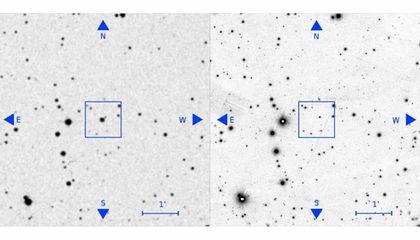Astronomers compare old views of the sky with what we see today and find that at least 100 stars appear to have vanished, or were perhaps covered up.
On March 16, 1950, astronomers at the US Naval Observatory pointed a telescope roughly in the direction of the constellation Lupus the wolf and took a picture. When scientists look at that same patch of sky today, something is missing, and it could be evidence of something else lurking out there.
Back in 2016, researchers in Sweden reported that a star had been lost. One of the roiling distant suns visible in that USNO image from the previous century could no longer be seen, even with the more advanced and sensitive digital sky surveys in use today.
The team published a paper on the discovery, but called it “very uncertain” at the time, resolving to do more follow-up work and to continue scouring old USNO observations for other celestial objects that seem to have gone missing.
Three years later, it’s still unclear what happened to that star spotted in 1950, but the team behind the “Vanishing & Appearing Sources during a Century of Observations” (Vasco) project now says they’ve found a hundred more missing stars like it by comparing old and new observations. While they’ve seen no signs of aliens just yet, they say parts of space where multiple stars seem to disappear could be the best places to look for extraterrestrial intelligence (ETI).
“Unless a star directly collapses into a black hole, there is no known physical process by which it could physically vanish,” explains a new study published in the Astronomical Journal and led by Beatriz Villarroel of Stockholm University and Spain’s Instituto de Astrofísica de Canarias. “The implications of finding such objects extend from traditional astrophysics fields to the more exotic searches for evidence of technologically advanced civilizations.”
The project team believes their search for vanishing stars could be useful in the search for extraterrestrial intelligence (SETI) by identifying “hot spots” in space where an unexpectedly large number of stars seem to be missing.
“Zooming in on the (hot spots) in our SETI (or technosignature) searches, we can identify the most probable locations to host extra-terrestrial intelligence,” they write.
The idea here is that a very advanced alien civilization may be able to construct a hypothetical megastructure called a Dyson sphere that completely encompasses a star in order to capture a large portion of its energy. Think of it as converting a star into a gargantuan battery. It’s far-fetched, but technically it would explain the sudden disappearance of a star.
For now, though, the hundred or so stars that have been seen going dark so far don’t appear to host aliens.
“But we are clear that none of these events have shown any direct signs of being ETI,” says co-author Martin López Corredoira in a statement. “We believe that they are natural, if somewhat extreme, astrophysical sources.”
Alien megastructures have been suggested as plausible explanations for other strangely behaving stars, like with erratically dimming and brightening Boyajian’s Star, but so far other natural explanations are more readily accepted by most scientists.
Next, the researchers hope to enlist the help of both citizen scientists and artificial intelligence to continue examining images for possible stars gone missing.
“Finding an actually vanishing star — or a star that appears out of nowhere — would be a precious discovery,” Villarroel says, “and certainly would include new astrophysics beyond the one we know of today,”













![Hotstar Premium Cookies 2019 [*100% Working & Daily Updated*] Hotstar Premium Cookies 2019 [*100% Working & Daily Updated*]](https://tahav.com/wp-content/uploads/2019/11/Hotstar-Premium-Cookies-Free-100x70.jpg)



